Nakshi Shika.Nakshi Pitha,Nakshi Pitha
Nakshi Shika.
Nakshi Shika embroidered reticulate bag made of jute strings featuring folk art motifs. It is usually made of jute. Shikas are found in almost every house of the rural areas of Bangladesh. This shika is fastened with the beam or ceiling of the house and different things of the family, including food stuff, are kept hanging there. The women are the makers of this form of art.
Though shika is made for domestic uses, skills in art and the sense of beauty of the artisan find expression through it. Embroidery is done on the shika with the help of glass-beads, cowries (shells used as a coin of the smallest denomination), round clods etc. Its diversity of joints and decoration processes are subjects of novelty. Different types of knots are used in making a shika, eg Maura knot, Rasun knot, Pagdi knot, Daman knot, Taha (Taka) knot, Badshi knot, Jhunti knot, Supari knot etc. The decoration that are added with these are siki (a quarter), Taka, Hatir Kan (ear of the elephant), Dalim etc. In some shikas, decoration of Astadal Padma and Kadam Phul are also seen.
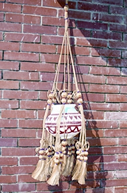 | 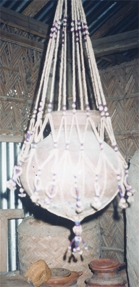 | 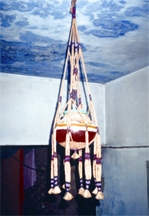 |
| Nakshi Shakia (Dhaka) | Nakshi Shika (Mymensingh) | Nakshi Shika (Rajshahi) |
The nakshi shika has different local names, eg jilapi, Amirti, Aulakeshi, Kauyar Thyang, Ichar Thyang, Jali, Bedi, Kautar Khopi etc. The shika has different names according to the style of making. Thus the shika hanged at two ends of a bamboo slip is named, ‘Bhar’ or ‘Bak’. The shika made for keeping Kantha (quilt) and pillows is known as Gainja, Panjab, Fulchanga (or Fultangi) etc. Fulchanga shika is made by knitting lahar or Jali (nets) at four corners or wheels of a bamboo and on it books, the holy quran, caps etc are kept. For keeping the quilts and pillows, a type of shika called jot made in braided hair net with four tiers, are also used. The shika used for hanging a large number of pots together is called the Hazari (thousand) shika. Moreover, there is a type of shika known as Hat (seven) shika, in which seven shikas are closely linked with one another. In it braided jute is twisted to make space for keeping small pots. It is found in Bera of Pabna district.
In the past shikas were made within the family and its purchase and sale was not so noticeable. At present, with increasing demand as well as appreciation of handicrafts these are being commercially made and have also got good foreign markets. Now the houses of city dwellers are often decorated with nakhshi shika.
Nakshi Pitha
Nakshi Pitha variety of rice cake with sundry designs made in villages and urban areas of Bangladesh. It is both a culinary art and an important women’s folk art.
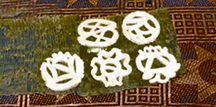
Nakshi pitha
In order to make nakshi pitha, dough is prepared by cooking atap-rice (unboiled rice) flour. The dough is then rolled out, and designs of plants, creepers and flowers are pricked out with date thorns, hairpins, needles, jute sticks, twigs, etc. Popular motifs include the lotus and intertwining circles. Pithas are also made by using patterned clay, stone, wood or metal moulds. The pithas are then fried in hot oil and soaked in a sugar syrup.
They may also be dried for later use and kept till needed. Women of greater mymensingh are famous for their dexterity in drawing variegated designs on these pitha, also known pakkuyan, teil pitha, or ful pitha (flower cake). The cakes are named after the designs. Common names are shabkhalata, kajal lata, chiral or chiranpata, hijalpata, sajnepata, uriyaful, bent or bhyat ful, padmadighi, sagardighi, sarpus, champabaran, kanyamukh, jamaimukh, jamaimuchda, satinmuchda, etc.
Designs are also imprinted upon puli pitha which is prepared with a filling of coconut and gud (molasses) or sugar. The edges of a puli pitha are pinched to look like flower petals.
Nakshi pitha of different flavours and shapes are made on various social and religious occasions, on eid, puja festivals, shab-e-barat, muharram, Khatna (circumcision ceremony), weddings, navanna (festival of newly harvested paddy in the month of Agrahayan), Paus festival, annaprashanA (Hindu rite of allowing a child to taste rice for the first time), aqiqah etc.
Nakshi pithas reveal the artistic skills of Bengali women as well as their hospitality which make a simple rice cake not only into a unique culinary but also a visual delight
Nakshi Pakha
Nakshi Pakha decorated hand-fan traditionally made by housewives and commercial artisans. The pakha or fan, has been in use in Bangladesh since ancient times and is still used extensively in rural areas where there is no electricity.
When decorated attractively with colourful designs, the fan is called nakshi pakha. The main raw materials for making nakshi pakha are yarn, bamboo, cane, date palm leaves, shola (sponge wood), palm leaves and flax. Peacock feathers and sandalwood are also used. When peacock feathers are used, no additional designs are necessary.
A variety of motifs are used to decorate nakshi pakha, the fan being named after the predominant motif: for instance, bhalobasa (love), kankair jala (comb’s hassle), guyapata (betel leaves), palangpos (bedspread), kavchanmala, chhitaphul, taraphul, shujaniphul (different flower motifs), balader chokh (eyes of a bull), shabkhalata (conchshell creeper), manbilasi (mind’s delight), manbahar (glamorous), baghbandi (the caged tiger), solakudir ghar (house of sixteen scores), mansundari (most desired beauty), lekha (written message), sagardighi (large lake), hati-phul-manus (elephant-flower-man), gambuj tola (dome), pashar dan (game of chess), yugal hans (pair of ducks), and yugal mayur (pair of peacocks).
A woman’s song from kishoreganj refers to yugal hans and yugal mayur: “ Someone has written [embroidered] on that fan a pair of ducks and a pair of peacocks.”
Designs may be embroidered or woven. Usually a round bamboo frame is attached to a bamboo handle. Coloured yarn, drawn from sari borders, is then drawn tightly across the round bamboo frame. With the help of a needle, coloured threads are woven in geometric patterns across the fixed strands. Occasionally, words or phrases are worked across the fan. Some favourite messages are: ‘Go, dear bird, tell him to forget me not’ and ‘Days pass but promises remain but time, meanwhile, flies away’. Attractive nakshi pakha are made of yarn in the chittagong area.
To make embroidered nakshi pakha, white cloth is attached to the round bamboo frame. Then different motifs are embroidered. The fan is finished off with a narrow strip of red cloth stitched around the edges of the frame to make a frill. Such fans are very popular in villages.
Fans made of bamboo and cane are woven like mats in round or square shapes. The most popular fan of rural Bangladesh is made of palm leaves. One leaf is sufficient for one fan. In order to make a fan, a palm leaf is cut in a round shape and framed with bamboo strips. Then triangular designs are made with fine strips of bamboo. These fans are very popular in the natore area.
Currently, fans made of sola (sponge wood) are sold in different folk fairs. These fans are very light in weight. They are made by pasting fine pieces of sola on a thin paperboard. At times paint is used to make the fans colourful. These fans are available in seasonal fairs.
Sandalwood fans are not made in this country, but in the 18th-19th centuries they were fashionable among women of affluent families. Nowadays, folding fans are made of palm leaves, in imitation of such sandalwood fans. They are popular, as they are easy to carry. Plastic fans are also being made today, in attractive colours but without decorative designs. The folk industry of fan making is, however, fast dwindling with the increasing availability of electricity and use of electric fans
Nakshi Darma
Nakshi Darma decorative bamboo screen. Designs are variously made: designs are carved on mature bamboo and green bamboo is twisted into delicate, interlaced patterns. The darma is usually used as an internal partition, but may occasionally be used as a fence of a village house. It is also known as baojhanp. The craft is popular in manikganj, kishoreganj and trishal. Common designs include flowers, ornamental creepers, lattice work, geometric designs, flying ducks, betel leaves, etc. Flying aircraft has also become popular
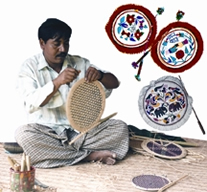


মন্তব্যসমূহ
একটি মন্তব্য পোস্ট করুন